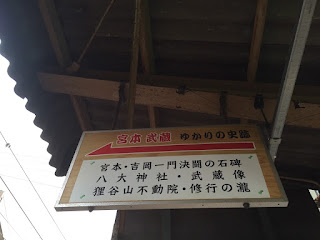According to the Japanese luna calendar, today is the end of winter though it is still as cold as ever.
It is not a national holiday, but Setsubun (節分) has important meaning as one of the customs characteristic of Japan.
Ehou-maki(恵方巻き)
I suppose you've seen and possibly had such a sushi roll, but I think it is not just a one you know. If you pay close attention, you will notice that it's uncut.
Setsubun is a special day for me, a big eater, to be able to eat it whole by myself.
biting into a whole, Marukajiri (丸かじり) / Marukaburi (丸かぶり)
Eho(恵方) of Eho-maki means a lucky direction. According to the custom, people look in the lucky direction of the year (with closed eyes), and silently bites into Ehou-maki while thinking of their wishes. The lucky direction of this year is Nan-Nan-Tou (南南東), south-southeast.
I gave a long speech about Eating Eho-maki, but it is not the main event at Setsubun.
We call them Risshun(立春: the first day of Spring), Rikka(立夏: the first day of Summer), Risshuu(立秋: the first day of Autumn), and Rittou(立冬: the first day of Winter).
However, Japanese people gradually placed great importance on Spring as the start of a year. That's why nowadays Setsubun refers to only the day before Spring.
Setsubun is on February 3rd or 4th, and today, February 3rd is Setsubun of this year because the date of Risshun varies with the years and Setsubun depends on it.
The main event at Setsubun is Mame-maki (豆まき), bean throwing. It is held with roasted soybeans in order to ward off the evil spirits. The roasted soybeans sold on the time is called Fukumame. It is also available at supermarkets or convenience stores and usually comes with a mask of Oni as a free gift. Oni is the ogre and symbol of evil spirits.
Fukumame (福豆), sacred beans and Oni no omen (鬼のお面), a mask of Oni
People call out while throwing beans through the windows or doors at night, Oni ha soto! Fuku ha uchi! (鬼は外!福は内!),
It means Devils out! Fourtune in!
After throwing beans, you should shut all the windows and doors as soon as possible, and eat the Fukumame equal to your age plus one. It is called kazoe-dpshi(数え年), traditional Japanese method counting your age.
It means if you are 20 years old now, you need to eat 21 beans. If you are 100 years old, it should be 101 beans, so the older we grow, the harder it is to eat them.
The scene of that father pretend Oni by using a mask and children enjoy Mame-maki can be often seen.
That's it brief introduction about Setsubun. Mamemaki is often held at shrines or temples for each area in Kyoto as Setsubun-sai(節分祭).
If you are looking for a shrine you should visit and besides the something special to do in Kyoto, I have a suggestion you can enjoy with your partner or / and family.
You can renew your vow being wrapped in Japan. For more information, visit our website http://wrappedinjapan.jp/
Cheers.






















































